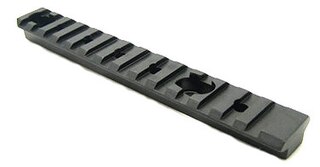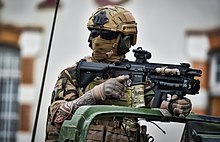The Colt Canada C7 and C8 are a Canadian family of service rifles, manufactured by Colt Canada, having similar design and function to the Colt M16A3.
The Springfield Armory M1A is a semi-automatic rifle made by Springfield Armory, Inc., beginning in 1971, based on the M14 rifle, for the civilian and law enforcement markets in the United States. "M1A" is a proprietary name for Springfield Armory's M14-pattern rifle. Early M1A rifles were built with surplus G.I. parts until Springfield Armory, Inc. began manufacturing their own. Robert Reese bought Springfield Armory from Elmer Ballance, and moved the manufacturing to Geneseo Ill in 1974.

The Heckler & KochXM8 is a lightweight assault rifle system developed from the late 1990s to early 2000s. The rifle was designed by German small arms manufacturer Heckler & Koch (H&K), and shares design and engineering with their G36 rifle.

The Picatinny rail, which meets MIL-STD-1913 rail, is an American design rail integration system that provides a mounting platform for firearm accessories. It forms part of the NATO standard STANAG 2324 rail. It was originally used for mounting of scopes atop the receivers of larger caliber rifles.

The Ares Defense Shrike 5.56 is an air-cooled, dual-feed rifle for semi or full-auto configurations that fires the 5.56×45mm NATO cartridge. The Shrike 5.56 can be supplied as a complete weapon, or as an upper receiver “performance upgrade kit” to existing M16-type service rifles and carbines. it is named after the Shrike, a carnivorous passerine bird, and was designed by Geoffrey Herring.
The Ruger 10/22 is a series of semi-automatic rifles produced by American firearm manufacturer Sturm, Ruger & Co., chambered for the .22 Long Rifle rimfire cartridge. It uses a patented 10-round rotary magazine, though higher capacity box magazines are also available. The standard carbine version of the Ruger 10/22 has been in production continuously since 1964, making it one of the most successful rimfire rifle designs in history, with numerous third party manufacturers making parts and accessories for upgrading and customization. The 10/22's aftermarket is so prolific that a complete 10/22 can be built without using any Ruger-made components.

A Weaver rail mount is a system to connect telescopic sights and other accessories to firearms and certain crossbows. It uses a pair of parallel rails and several slots perpendicular to these rails.
The Z-M LR-300 is an American rifle designed by gunsmith Allan Zitta and manufactured by Z-M Weapons. The model name LR-300 stands for Light Rifle and 300 is for 300 meters, which is regarded by the manufacturer as the effective range of the rifle with a standard 55 gr (3.6 g) FMJ bullet. The design is based on the AR-15, M16 and C7 rifles, but has a unique semi-direct gas impingement system and a folding stock option.

Daewoo Precision Industries K2 assault rifle is the standard service rifle of the South Korean military. It was developed by the South Korean Agency for Defense Development and manufactured by SNT Motiv and Dasan Machineries. Shoulder-fired and gas-operated, the K2 is capable of firing both 5.56×45mm NATO and .223 Remington ammunition; however, using .223 Remington is only recommended for practicing for short distance.
The SG 550 is an assault rifle manufactured by SIG Sauer AG in Switzerland. "SG" is an abbreviation for Sturmgewehr. The rifle is based on the earlier 5.56×45mm NATO SIG SG 540.

The SR-3 Vikhr is a Russian 9×39mm compact assault rifle. It was developed by A. D. Borisov, V. N. Levchenko and A. Tyshlykov at TsNIITochMash in the early 1990s and was manufactured in 1994. Heavily based on the AS Val, but lacks an integral suppressor, has a newly designed folding stock and charging handle for ease of concealed carry. The abbreviation "SR" stands for spetsialnaya razrabotka — special development.

A barrel shroud is an external covering that envelops the barrel of a firearm, to prevent unwanted direct contact with the barrel. Moving coverings such as pistol slides, fore-end extension of the gunstock/chassis that do not fully encircle the barrel, and the receiver of a firearm itself are generally not described as barrel shrouds, though they can functionally act as such.

The karabinek wz. 1996 Mini-Beryl is a Polish compact assault rifle (carbine) derived from the FB Beryl service rifle and chambered for 5.56×45mm. It was developed in parallel with the wz. 1996 Beryl by the "Łucznik" Arms Factory in Radom and introduced into service with the Polish Armed Forces in 1997 as the 5,56 mm karabinek krotki wz. 1996.

The NATO Accessory Rail (NAR), defined by NATO Standardization Agreement (STANAG) 4694, is a rail interface system standard for mounting accessory equipment such as telescopic sights, tactical lights, laser aiming modules, night vision devices, reflex sights, foregrips, bipods and bayonets to small arms such as rifles and pistols.

The IWI Galil ACE is a series of assault rifles and battle rifles originally developed and manufactured by Israel Weapon Industries (IWI). It is produced in three different calibres: 5.56×45mm NATO, 7.62×39mm and 7.62×51mm NATO.

KeyMod is a universal interface system for firearm accessory components designed to supersede the MIL-STD-1913 "Picatinny" accessory rails. The concept was first created by VLTOR Weapon Systems of Tucson, Arizona, and released through Noveske Rifleworks of Grants Pass, Oregon, before being published open sourced in the public domain for adoption by the entire firearms accessory industry. The name "KeyMod" was coined by Eric Kincel following the naming trend of other VLTOR accessories with the suffix "Mod" meaning modular, and "Key" being a reference to the key-hole profile of the mounting slots.

M-LOK, for Modular Lock, is a firearm rail interface system developed and patented by Magpul Industries. The license is free-of-charge, but subject to an approval process.

The UIT rail, also known as Anschutz rail, is a standard used for mounting slings and other gun accessories in competition shooting, and is essentially a T-slot track shaped aluminium extrusion profile accepting attachments in the form of T-slot nuts, or similar.

A dovetail rail or dovetail mount can refer to several types of sliding rail system found on firearms, primarily for mounting telescopic sights. Colloquially, the term dovetail rail usually refer to any straight mounting bracket with an inverted trapezoid (dovetail) cross-section running parallel to the bore for mounting a scope or diopter sight to a rifle. These are sometimes also called "tip-off" mounts, and allow the user to easily take on or off the sight. Dovetail mount can also refer to a dovetail track running perpendicular to the bore.

Scope mounts are rigid implements used to attach (typically) a telescopic sight or other types of optical sights onto a firearm. The mount can be made integral to the scope body or, more commonly, an external fitting that clamp onto the scope tube via screw-tightened rings. The scope and mount are then fastened onto compatible interfaces on the weapon. Words such as mounts and bases are used somewhat loosely, and can refer to several different parts which are either used together or in place of each other as ways to mount optical sights to firearms.





















